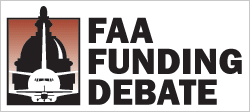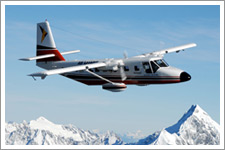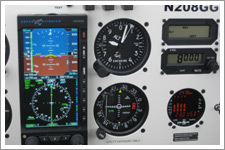| This ePilot is sponsored by

Advertisers
                  
Got news? Contact ePilot. Having difficulty using this service? Visit the ePilot Frequently Asked Questions now at AOPA Online or write to [email protected].
421 Aviation Way
Frederick, MD 21701
Tel: 800/USA-AOPA or
301/695-2000
Copyright © 2008 AOPA.
| | Click here to view this week's custom content online. | | GA News | | NO USER FEES FOR NOW, CONGRESS EXTENDS FAA FUNDING
 Congress has once again extended the current FAA funding system, preserving the status quo on aviation taxes and fees until Sept. 30. "The good news is that aviation fuel taxes won't change during the summer flying season, and there are no new user fees," said Phil Boyer, AOPA president. "And this extension will let airports spend all of their Airport Improvement Program grants during this construction season. The bad news is that user fees still remain a possibility." Read more on AOPA Online. Congress has once again extended the current FAA funding system, preserving the status quo on aviation taxes and fees until Sept. 30. "The good news is that aviation fuel taxes won't change during the summer flying season, and there are no new user fees," said Phil Boyer, AOPA president. "And this extension will let airports spend all of their Airport Improvement Program grants during this construction season. The bad news is that user fees still remain a possibility." Read more on AOPA Online.
BOYER COUNTERS BIASED THINK TANK REPORT
When a Washington, D.C., think tank leaked a copy of its report on business aviation to the national media a day ahead of its scheduled release, reporters turned to AOPA, which immediately rose to the defense of general aviation. "Even before the report was public, we were on the record, punching holes in it," said AOPA President Phil Boyer. The Institute for Policy Studies report might as well have been written by the airlines: It contains almost all of the discredited arguments they've made in support of user fees over the past three years. Read more on AOPA Online.
CONGRESSIONAL SECURITY STUDIES MIGHT AFFECT GA
 Can the Civil Air Patrol provide more assistance to the Department of Homeland Security? Can "biometric identifiers" be added to airport ID cards? Congress wants to know. "The answers to these questions might affect general aviation pilots, so AOPA will be part of the study process," said Craig Spence, AOPA's new vice president of aviation security and a former Department of Homeland Security official. "We will continue to work with DHS to ensure that any new security actions are reasonable and appropriate to the actual level of risk." Read more on AOPA Online. Can the Civil Air Patrol provide more assistance to the Department of Homeland Security? Can "biometric identifiers" be added to airport ID cards? Congress wants to know. "The answers to these questions might affect general aviation pilots, so AOPA will be part of the study process," said Craig Spence, AOPA's new vice president of aviation security and a former Department of Homeland Security official. "We will continue to work with DHS to ensure that any new security actions are reasonable and appropriate to the actual level of risk." Read more on AOPA Online.
AOPA FIGHTING TO SAVE MAINE AIRPORT
As a November referendum on closing Biddeford Municipal Airport in Biddeford, Maine, draws closer, AOPA is continuing its campaign to gain community support for the field. Delivering the message that "a vote to close the airport is a vote for higher taxes for residents," AOPA Vice President of Local Airport Advocacy Bill Dunn met with reporters, city officials, and a local airport support group to discuss the future and importance of the field. Read more on AOPA Online.
NEW FLIGHT PLAN FORM GOES INTO EFFECT
Starting June 29, pilots filing instrument flight plans requesting RNAV standard instrument departure and arrival routes (SIDs and STARs) will need to file an ICAO flight plan form. Those who file VFR flight plans, IFR flight plans without RNAV SIDs or STARs, or RNAV routes to fly direct can still use the FAA flight plan form. The switch is part of an FAA upgrade to en route air traffic control software designed for pilots who navigate using RNAV-qualified equipment. The ICAO flight plan form asks for more equipment information than the FAA's form. To help you determine which equipment suffix to enter in the flight plan form, the FAA has issued a letter to airmen with a chart listing the suffixes. For more information, see AOPA's detailed brief on filing an ICAO flight plan for domestic operations.
AVIATION PIONEER JOHNNY MILLER DIES AT 102
A pilot who was almost as old as powered aviation itself has died. John M. Miller was 102. Miller, of Poughkeepsie, N.Y., died of natural causes on June 23. Miller was born on Dec. 15, 1905, and witnessed some of aviation's most pivotal events such as when Charles A. Lindbergh took off for Paris on his historic Atlantic crossing. Miller counted Amelia Earhart as one of his acquaintances. He uttered his last words to his nephew. "I guess my flying days are over," reported the Poughkeepsie Journal. Read more on AOPA Online.
ECLIPSE TAKES STEPS TO PREVENT ENGINE CONTROL ISSUES
In response to the recent incident in Chicago where a pilot exceeded the design range of movement of the Eclipse 500 thrust levers during a go-around, Eclipse Aviation is incorporating changes to the very light jet's software. Eclipse intends to increase the range limit of the throttle quadrant assembly (TQA) to prevent the fault condition, pending approval from the FAA. Read more on AOPA Online.
AUSSIE ICON MAKING COMEBACK
 Gippsland Aeronautics has acquired the type certificate of the twin turboprop Nomad from Boeing Australia, revealing plans to put the icon of outback aviation back in production and naming a pair of launch customers. Terms of the deal were not disclosed, nor has Gippsland released pricing information or production details. Still, the Australian government believes new Nomad production could reach 200 units and $700 million in export sales over the next decade. Read more on AOPA Online. Gippsland Aeronautics has acquired the type certificate of the twin turboprop Nomad from Boeing Australia, revealing plans to put the icon of outback aviation back in production and naming a pair of launch customers. Terms of the deal were not disclosed, nor has Gippsland released pricing information or production details. Still, the Australian government believes new Nomad production could reach 200 units and $700 million in export sales over the next decade. Read more on AOPA Online.
ELECTRIC AIRPLANES ARE FLYING BUT FAR FROM MARKET
Many companies will display electric-powered airplanes at Oshkosh this year, but a practical airplane you can purchase has proven to be a challenge. The Experimental Aircraft Association has asked the FAA to allow light sport aircraft to use electric propulsion, so there is a lot of interest. Find out what electric airplanes are in development on AOPA Online.
CLUBS OFFER CAMARADERIE AS WELL AS FLIGHT TIME
If you're looking for fun and friends to go with your flying, a club may be the perfect place for you. Many flying clubs plan fly-outs and other adventures in addition to regularly scheduled club meetings. Depending on your club's character, meetings may be no-nonsense business affairs or good excuses for a little hangar talk. "Interacting with a club has enabled me to grow as a pilot, beyond my primary training or instruction," said Ryan Rodd, president of the Yellow Jackets Flying Club. "It has created a support network to turn to when I've had questions or problems, or just needed an aviation 'fix.'" Read more on AOPA Online.
WEB SITE HIGHLIGHTS LITTLE-KNOWN AIRFIELDS
Some of the best content on the Web is being compiled by dedicated amateurs with a passion for a particular field of interest. Paul Freeman of Sterling, Va., has created a Web site about abandoned and little-known airfields. Since 1999, the site, which is broken down by state, has grown to include information and photos on nearly 1,400 airports. It provides a fascinating and often overlooked side of American history. For more on Freeman's efforts, see AOPA Online.
For daily news updates, see AOPA Online.
| | Safety & Proficiency | | TEST YOUR KNOWLEDGE OF RUNWAY SIGNS AND MARKINGS
Historically, general aviation operations account for the majority of runway incursions. To improve that record, pilots need to maintain vigilance and situational awareness while operating in the airport environment. Test your knowledge of airport signage and pavement markings, progressive taxi instructions, land-and-hold-short operations, and more with the latest AOPA Air Safety Foundation Safety Quiz. Then study the runway environment with the foundation's free runway safety resources, including an online course, flash cards, and airport taxi diagrams.
FSS TIP OF THE WEEK: DUAL FREQUENCIES
Pilots often contact flight service en route to get updated weather, open flight plans, or obtain other information. In some areas, the best radio reception will be near a VOR. Pilots transmit on a frequency such as 122.1R. The "R" indicates this is a "receive only" frequency for flight service briefers. To listen to the callback from flight service, pilots must tune to the associated VOR frequency. However, it is easy to confuse which frequency is for talking and which is for listening. Remember, "Don't talk to VORs." Pilots should listen to flight service over the same frequency on which they listen to a VOR's Morse code when identifying a station. See examples and listen to sample radio calls in the AOPA Air Safety Foundation's online minicourse, A Pilot's Guide to Flight Service .
GPS: INNOVATE, STANDARDIZE, OR BOTH?
More than a decade ago, five GPS manufacturers made IFR-approved receivers, and the AOPA Air Safety Foundation and FAA requested a group meeting to discuss standardization. "Obviously, we didn't prevail in what I still think was a commonsense human factors approach," writes Bruce Landsberg in his latest blog entry. "As we start to see some maturity in the GPS market and even a few new players coming back in to broaden the field, is it time to ask the same question again or should market forces continue to hold sway?"
| | Inside AOPA | | PIC EXPERTS UNDERSTAND OWNERSHIP FIRSTHAND
Got a question about aircraft ownership? Get answers from an aircraft owner. If Rodney Martz happens to take your call to the AOPA Pilot Information Center (800/USA-AOPA), you'll be talking to someone who has lots of firsthand experience owning aircraft. In fact, Martz has owned one or more aircraft continuously since 1974. Today he owns four airplanes—a Bonanza, two Cessnas, and a Grumman. So if you've got a question about aircraft ownership, this 18-year AOPA employee has an answer. Read more on AOPA Online.
IMPROVED SAFETY RECORD LOWERS AVIATION INSURANCE PREMIUMS
As the economy and fuel prices force pilots to look for ways to lower the cost of flying, there is good news on the aviation insurance front. Recognizing the improving general aviation safety record on a large number of GA aircraft types, aviation insurance underwriters are offering rate reductions. While not all aircraft will see rate reductions, and certain state restrictions may apply, many GA piston aircraft owners could see savings. Read more on AOPA Online.
Changing mailing or e-mail addresses? Click here to update.
| | Quiz Me | | Here's a question asked by an AOPA member who contacted our aviation services staff through the AOPA Pilot Information Center. Test your knowledge.
Question: Is my Cessna 152 required to have a compass deviation card?
Answer: Yes, all standard category aircraft are required to have a compass card placard for the magnetic compass per FAR 23.1547. The placard must show the calibration of the instrument in level flight with the engines operating and must state whether the calibration was made with radio receivers on or off. To learn more about the magnetic compass and deviation, read " In Defense of the Compass," an article from AOPA Flight Training .
Got a question for our aviation services staff? The AOPA Pilot Information Center is a service available to all members as part of the annual dues. Call 800/872-2672, or e-mail to [email protected]. Send comments on our Quiz Me! questions to [email protected].
| | Get Your Glass Sweepstakes Update | | HOW HIGH, HOW FAST, HOW COMFORTABLE
 Follow along on this week's sweepstakes update as we digest the numbers from a trip with the glass-equipped Piper Archer from its home base at Frederick, Md., to Osage Beach, Mo., for the annual Cherokee owners fly-in and convention. Learn what worked well and what didn't, and see what the world looked like from 9,000 feet in this week's update. Follow along on this week's sweepstakes update as we digest the numbers from a trip with the glass-equipped Piper Archer from its home base at Frederick, Md., to Osage Beach, Mo., for the annual Cherokee owners fly-in and convention. Learn what worked well and what didn't, and see what the world looked like from 9,000 feet in this week's update.
| | Picture Perfect | | The AOPA Online Gallery allows you to download your favorite aviation images to use for wallpaper or send a personalized e-card. Search the hundreds of fabulous images in our archives and select your favorites today! For more details, see AOPA Online.
| | Weekend Weather |  | | ePilot Calendar | | UPCOMING FLYING DESTINATIONS:
Sanford, Maine. An airport open house and car show takes place June 28 at Sanford Regional (SFM). For more information, contact Evan R. McDougal, 207/432-0596.
Gardner, Kan. A vintage fly-in takes place June 28 at Gardner Municipal (K34). For more information, contact Jeff Sullens, 816/729-3151.
South Lake Tahoe, Calif. An airshow takes place June 28 at Lake Tahoe (TVL). For more information, contact Rick Jenkins, 530/542-6182, or visit the Web site.
Concrete, Wash. An open cockpit day takes place June 28 at Concrete Municipal (3W5). For more information, contact Jim Jenkins, 360/770-4848, or visit the Web site.
To submit an event to the calendar or to search all events visit AOPA Online. For airport details, including FBO fuel prices, see AOPA's Airport Directory Online.
FLIGHT INSTRUCTOR REFRESHER CLINICS
The next AOPA Air Safety Foundation Flight Instructor Refresher Clinics are scheduled in San Jose, Calif., June 28 and 29. For a complete schedule, see AOPA Online. Can't make it in person? Sign up for the CFI Refresher Online.
AOPA AIR SAFETY FOUNDATION SAFETY SEMINARS
AOPA Air Safety Foundation Safety Seminars are scheduled in Wichita, Kan., Ypsilanti, Mich., and Germantown, Tenn., on September 8. Topics vary—for details and a complete schedule, see AOPA Online.
|
| Member Tools: | | Editorial Team: | | | | - ePilot Editor: Alyssa Miller
- Contributors: Nate Ferguson, Warren Morningstar, and Alton Marsh
|  | |